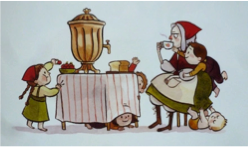Leave Me Alone!
- lcollins29
- Apr 27, 2017
- 2 min read
Title: Leave Me Alone!
Author/Illustrator: Vera Brosgol
Publisher: Roaring Book Press New York
Publication Year: 2016
Professional Source: Kent County Library
Genre (and subcategory, if appropriate): Fiction Picture Book
Audience: Children
Awards: Caldecott Medal


Leave Me Alone! is the heartwarming story of a grandmother who only wishes to finish her knitting. Brosgol, its author, is originally from Russia and certain Russian influences are prevalent throughout the story. The style of clothing that the people are wearing, and the village that is briefly shown in the story both radiate an old Russian style. On one page you can see the village that the old woman lives in—a place filled with log cabins, chimney fireplaces and men wheeling around piles of logs. Even the terrain and the animals—deep forests filled with bears and snowy mountains covered with goats—match up to what a person would find in the Russian wilderness. The most obvious sign, however, is the grandmother’s use of a samovar (pictured above)—a notable attribute of Russian households—to boil her tea. Most of these things aren’t seen in modern times, so they give the story an old timey feeling to it, though it is a very modern tale. Its contemporary aspects come from the mentions of aliens and wormholes and the casual way that the lady interacts with these things. Both children and adults can enjoy the impossible feats of this old character.
Parents and grandparents especially will be able to see themselves in this old lady as she marches about struggling to get her work done. It is clear that she is trying to provide for her children and is only frustrated because someone is always getting in the way. This idea and type of story is reminiscent of crossover texts described in Chapter 2 of Reading Children’s Literature, ones that were written for adults but were loved by children. Sometimes an adult just needs a short period of time away from everyone else, which is what leads her to scream at the top of her lungs, “Leave me alone!”
The author did not intend for this book to have a teaching point, but the book does its job of entertaining the audience. Readers will enjoy the colorful nature of the pictures and the strategic way that the colors of the characters and the landscape are interspersed with pages of mainly white space. For example, at the end of the book, after seeing multiple pages of colorful mountains and forests, the grandmother finally finishes her knitting and the final picture is of her surrounded by her children with only white space around them all. Molly Bang stated, “the center of the page…is the point of greatest attraction.” (62) In other words, the object in the center of the page is the most important, and in this situation, the most important subject is the happiness the grandmother experiences with her children at the end of the story. The switches between full pages of color and pages of white space help the reader keep their focus on what is most important in the picture (usually the old woman) and allows for smaller, more amusing details (such as a goat eating a ball of yarn) to be noticed later.






Comments